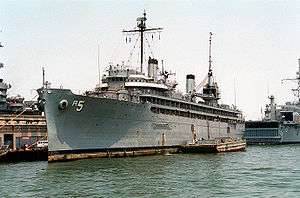Auxiliary ship
An auxiliary ship is a naval ship designed to operate in support of combatant ships and other naval operations.[1] Auxiliaries are not primary combatants,[2] although they may have some limited combat capacity, usually of a self-defence nature.
Auxiliaries are extremely important for navies of all sizes, as without them, the primary fleet vessels cannot be effective. Thus, nearly every navy maintains an extensive fleet of auxiliaries. However, the composition and size of these auxiliary fleets varies depending on the nature of each navy and its primary mission. Smaller coastal navies tend to have smaller auxiliary vessels focusing primarily on littoral and training support roles. Larger blue-water navies tend to have large auxiliary fleets comprising longer-range fleet support vessels designed to provide support far beyond territorial waters.
Roles
.jpg)
_conducts_a_refueling_at_sea_with_Australian_auxiliary_oiler_HMAS_Sirius_(AOR_266)_as_dock_landing_ship_USS_Tortuga_(LSD_46)_approaches_during_exercise_Talisma.jpg)


_is_moored_alongside_the_U.S._Naval_Academy's_Dewey_Seawall.jpg)
- Replenishment
- One of the most direct ways that auxiliaries support the fleet is by providing underway replenishment to major fleet units. This allows the fleet to remain on station, with the replenishment vessels bringing up fuel, ammunition, food, and supplies from shore to the fleet wherever it is operating. Oilers (AO AOG) are vessels specifically designed to bring fuel oil to the fleet, while the earlier Colliers supplied coal burning steamships. Some replenishment vessels: Combat stores ship, Depot ship, General stores issue ship and Ammunition ship (AC, AE, AF, AFS, AKE, AOE, AOR). Tenders are specifically designed to support a type of smaller naval unit, like submarines, Destroyer and seaplanes, providing a mobile base of operations for these units. Tenders: Destroyer Tender (AD), Submarine tender (AS), Seaplane Tender (AV, AVB, AVP, AVS), Torpedo boat tender (AGP) and Miscellaneous Auxiliary (AG).[3][4]
- Transport
- Supporting forward operating bases requires immense transportation capacity. Transports are often converted merchant ships simply commissioned (APA, APD, APH, APV) into naval service. Tankers are transports specifically designed to ship fuel to forward locations. Transports are often employed not only carrying cargo for naval support, but in support of all forces of a nation's military (AK, AKA, AKN, AKR, AKS). In particular, troopships and attack transports are used to carry large number of soldiers to operational theatres. Some transport ships are highly specialized, like the ammunition ships employed by the US Navy. Large ocean tugs (AT, ATO, ATF, ATA, ATR) are used to tow large auxiliary ships, like: barges, floating repair dock and floating cranes in open sea, also disabled ships.[5][6][7][8][9][10][11][12][13][14]
- Repair
- Repairing ships at sea or in forward areas is important as it allows these units to return to service quicker, while also increasing the chance of survival for ships critically damaged in battle. Repair vessels (AR, ARB, ARC, ARG, ARH, ARL, ARV) range from small equipment ships to Auxiliary repair docks, and lager Auxiliary floating drydock.[15]
- Harbor
- Harbor support is a critical support role, with various types of vessels including tugboats, barges, lighters, derrick-crane vessels, and others, used to move ships and equipment around the port facilities, and depot ships and tenders to service ships currently in the harbor. These vessels also help maintain the harbor by dredging channels, maintaining jetties and buoys, and even providing floating platforms for port defense weapons. Tugboats are type YT, YTB, YTM, YTL or a Type V ship.[16] Barges are classified as a Type B ship or YF, YFN YFR and YFRN.[17][18]
- Support
- Radar picket to increase the radar detection range around a force. Communications Relay Ships (AGMR) are floating communications stations. Tracking ship or Range Instrumentation Ship (AGM) are equipped with antennas and electronics to support the launching and tracking of missiles and rockets. Command ship (AGF) are flagships of the commander of a fleet. Wind-class icebreaker (AGB WAGB) are support ships. Rescue and salvage ship and Submarine rescue ship (ASR) for surface support ship for ship and submarine rescue. Barracks ship or Auxiliary Personal Living, (APL) are vessels-barges for service men to live on.
- Research
- A wide variety of vessels are employed for research(AGTR) (AGM), Environmental Research Ships (AGER), Hydrofoil Research Ships (AGEH) and survey, primarily to provide a navy with a better understanding of its operating environment, or to assist in testing new technologies for employment in other vessels.
- Hospital
- Hospital ship are able to provide care in remote locates.
References
Notes
- Cutler and Cutler, p.16
- Morris, p.192
- "Submarine Tenders (AS)". shipbuildinghistory.com. Retrieved 2019-01-23.
- "Other Auxiliaries(AGB, AGC, AGDS, AGEH, AGER, AGF, AGM, AGMR, AGP, AGR, AGTR)". shipbuildinghistory.com. Retrieved 2019-01-23.
- "Ocean Tugs (AT, ATO, ATF, ATA, ATR)". shipbuildinghistory.com. Retrieved 2019-01-23.
- "Oilers AO". shipbuildinghistory.com. Retrieved 2019-01-23.
- "Combat Logistics Resupply Ships AC AE AF AFS AKE AOE AOR". shipbuildinghistory.com. Retrieved 2019-01-23.
- "Cargo Ships AK AKA AKN AKS". shipbuildinghistory.com. Retrieved 2019-01-23.
- "Gasoline Tankers AOG". shipbuildinghistory.com. Retrieved 2019-01-23.
- "Destroyer Tenders AD". shipbuildinghistory.com. Retrieved 2019-01-23.
- "Aviation Support Ships AV AVP AVS". shipbuildinghistory.com. Retrieved 2019-01-23.
- "Miscellaneous Auxiliaries AG". shipbuildinghistory.com. Retrieved 2019-01-23.
- "Troop Transports (AP)". shipbuildinghistory.com. Retrieved 2019-01-23.
- "Attack and Other Transports (APA, APD, APH, APV)". shipbuildinghistory.com. Retrieved 2019-01-23.
- "Floating Dry-Docks (AFDB, AFDM, AFDL, ARD, ARDM, YFD)". shipbuildinghistory.com. 30 April 2015. Retrieved 8 January 2019.
- "Yard Tugs Wartime YT YTB YTM YTL". shipbuildinghistory.com. Retrieved 2019-01-23.
- "Freight Lighters Wartime YF YFN YFND YFR YFRN YFRT". shipbuildinghistory.com. Retrieved 2019-01-23.
- "Freight Lighters Wartime YF YFN YFND YFR YFRN YFRT". shipbuildinghistory.com. Retrieved 2019-01-23.
- "Other Auxiliaries AGB, AGC, AGDS, AGF, AGM, AGMR, AGP, AGR". shipbuildinghistory.com. Retrieved 2019-01-23.
Bibliography
- Cutler, Deborah W.; Cutler, Thomas J. (2005). Dictionary of Naval Terms (6 ed.). Naval Institute Press. ISBN 978-1591141501.
- Morris, Christopher G. (1992). Academic Press Dictionary of Science and Technology (1 ed.). Academic Press. p. 192. ISBN 978-0127356327.
role of auxiliary vessels.
External links

